Martin P.M. Handbook of Deposition Technologies for Films and Coatings, Third Edition: Science, Applications and Technology
Подождите немного. Документ загружается.


Characterization of Thin Films and Coatings 751
the range of information that can be provided by a selection of conventional and some newly
developing characterization methods.
The growing need for film, coating, interface, and surface characterization has stimulated a
growth of industry in the development of analysis tools, the creation of specialized
organizations within companies to address specific measurements, and independent consultants
that can expertly perform such measurements. By taking advantage of the assistance of experts
at companies or user facilities, a researcher can use the sophistication of the instruments and
capabilities without being a technique expert [1]. However, for those seeking information, it is
highly useful to understand what types of information can be obtained by different methods
and the likely sensitivity. Tables and figures in this section provide a highly simplified
overview of the types of information that can be obtained by different analysis methods. They
are intended to help guide a researcher or engineer toward what might be the most useful
technique(s) for a specific need. It must be recognized that many materials are exceptional in
different ways and issues related to damage, sensitivity, or single interface may alter the
relative value and importance of different methods. Some advantages and limitations of the
different methods are included in the descriptions of the specific methods.
Table 16.1 provides a list of the methods summarized in this chapter along with a brief
indication of the information that can be obtained. The techniques are organized by the nature
of the incident or probe beam used to initiate the information process. Because methods can be
used in a variety of ways and combinations to produce specific types of information, Table 16.2
organizes the methods by types of information that may be obtained from a given sample.
Although these tables are useful, it is not easily possible to create compact tables that provide
all of the needed information in a useful form. Several approaches have been made by different
organizations to summarize information from different techniques.
Two bubble charts created by Evans Analytical Group (EAG) [2] and National Physical
Laboratory (NPL) [3] have proven to be highly useful. The NPL bubble chart on surface and
nanoanalysis (Figure 16.1) summarizes the types of information that can be extracted from
specific methods and the spatial resolution of the methods. The NPL chart nicely complements
the analytical resolution versus detection limit information contained in the EAG chart
(Figure 16.2). The real value of these bubble charts is that they identify important aspects of
many different analysis methods in an understandable fashion. Such charts can be used to
guide a potential user toward useful methods to obtain the information needed. However, it
remains important to explore the most relevant methods in more detail to determine whether
the desired information can actually be obtained.
In the technique descriptions that follow, several techniques are summarized. One objective in
each area has been to provide a general overview of how the method works. For each method a
short summary of strengths and limitations is provided. Because each method can be used in
relatively simple or much more sophisticated ways, it is useful to explore methods of potential

752 Chapter 16
Table 16.1: Film, coating, and surface characterization methods ordered by incident or probing
beam
Probing beam Technique Types of information
Photons X-ray photoelectron
spectroscopy (XPS)
Surface composition (Li and heavier), surface
chemical state
X-ray diffraction (XRD) Film crystal structure and phase
X-ray reflectance (XRR) Film thickness and interface roughness
Laser Raman Molecular structure
Fourier transform infrared
spectroscopy (FTIR)
Molecular structure
Ellipsometry Film thickness
Photoluminescence
spectroscopy
Luminescence properties
Ions Rutherford backscatt ering
spectrometry
Film composition, film thickness, elemental
profiles, information about interf ace
Nuclear reaction analysis Specific isotope composition and distribution
Ion channeling Crystalline quality and defect (impurity)
locations, information about interface
Elastic recoil detection
analysis
Light element concentration and depth
distribution
SIMS/Nano-SIMS/TOF-
SIMS
Molecular and elemental species
Low-energy ion scattering Outer surface composition, surface structure
Glow discharge mass
spectrometry
Depth profile
Focused ion beam Ion-induced EDS, secondary ion microscopy,
ion-induced secondary electron microscopy,
nanolithography (site specific cr oss-sections),
film surface cleaning
Electrons Auger electron
spectroscopy
Surface elemental (and chemical state)
composition
Scanning electron
microscopy
Surface topography, film thickness?
Transmission electron
microscopy
Microstructure, chemical information, film
thickness?
Low-energy electron
diffraction
Surface structure
Energy-dispersive X-ray
spectroscopy
Composition and composition distribution
Other Methods Scanning probe methods
(STM, AFM, etc.)
Topography, electronic structure, site-specific
information
Atom probe microscopy Atom distributions
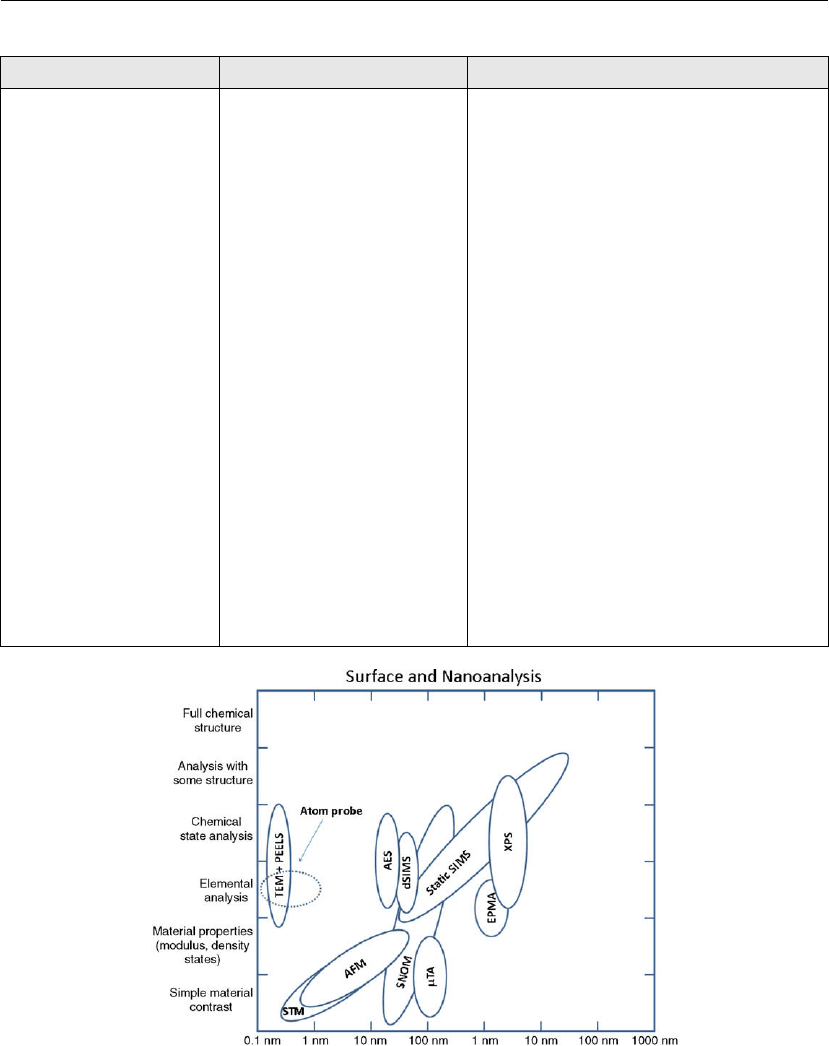
Characterization of Thin Films and Coatings 753
Table 16.2: Types of information needed and useful characterization methods
Information Method Comments or range of applicability
Composition
Surface composition XPS Outer 10 nm
AES Outer 10 nm
SIMS Outer 1 nm
LEIS Outer < 1 nm
Depth distribution Ion sputter profiles with
XPS, AES, or SIMS
Less than a few m
RBS/NRA Up to 2 m
Film thickness XRR 10 nm < thickness < 1 m
XPS 1 nm resolution, 10 nm depth
TEM Need cross-section
RBS Up to 2 m
Ellipsometry
Structure XRD Phases and orientations
RHEED Structure during growth
LEED Surface structure
TEM electron diffraction Structure with spatial resolution
Film surface roughness AFM
Profilometry
Molecular structure Raman/IR Non-destructive
TOF-SIMS Destructive
Figure 16.1: Diagram showing types of information that can be collected and spatial resolution of
a variety of surface and materials analysis methods. Many of the methods are listed in Table 16.1.
(Diagram prepared by the National Physical Laboratory [3], Teddington, UK; used with
permission.)
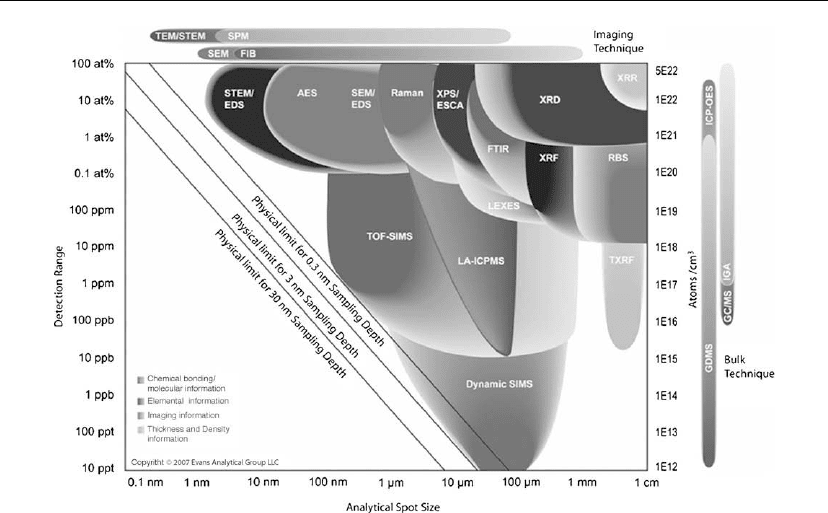
754 Chapter 16
Figure 16.2: Diagram of analysis resolution versus detection limit for a variety of analytical
methods. (Chart developed by Evans Analytical Group [2]; used with permission.)
interest in much more detail and appropriate references are provided. Increasingly useful
information is available on the internet. Wikipedia references on some techniques are quite
good and can provide a useful introduction. Many vendor sites also provide general
information about methods in addition to specific details of the equipment they manufacture.
A range of excellent new and older books have been published that cover such topics as
‘Fundamentals of Surface and Thin Film Analysis’ [4], ‘Analytical Techniques for Thin
Films’ [5] and materials characterization [6].
16.3 Incident Photon Methods
Techniques involving incident photons are described and some brief examples of application
are shown. Methods included are: X-ray photoelectron spectroscopy (XPS), X-ray diffraction
(XRD), X-ray reflectivity (XRR), optical methods such as laser Raman spectroscopy (RS) and
Fourier transform infrared spectroscopy (FTIR), ellipsometry, and photoluminescence
spectroscopy. One advantage of the fully optical methods including FTIR, ellipsometry, and
Raman is that they can be conducted in any environment for which the optical path can be
established, including liquid and solid environments. Consequently, measurements may be

Characterization of Thin Films and Coatings 755
conducted during growth or in reactive environments. In contrast, vacuum-based methods,
such as XPS, have more restrictive operation requirements.
16.3.1 X-Ray Photoelectron Spectroscopy
M.H. Engelhard
16.3.1.1 Introduction
XPS involves the detection of photoelectrons emitted from a sample as a result of irradiation
of the sample by single-energy X-ray photons. XPS or electron spectroscopy for chemical
analysis (ESCA) has become a relatively simple and increasingly routine technique for the
compositional and chemical state analysis of surfaces. The basic principle of XPS is the
photoelectric effect discovered by Hertz in 1887 [7, 8] and extended to surface analysis
by K. Siegbahn and his research group at Uppsala University, Sweden, during the
mid-1960s. Siegbahn won the Nobel Prize in Physics in 1981 for his work in XPS and
coined the acronym ESCA [9]. Both XPS and ESCA are commonly used to describe this
technique.
XPS is useful for quantitative analysis of surface composition and can detect all elements with
the exception of hydrogen and helium through the detection of the binding energies of the
photoelectrons. Small variations in binding energies of the photoelectron lines as well as
Auger lines (see Section 16.5.1), satellite peaks, and multiple splitting can be used to identify
chemical states. XPS is initiated by irradiating a sample with monoenergetic soft X-rays, most
commonly Mg Kα (1253.6 eV with a line width ≈0.7 eV) or Al Kα (1486.6 eV with a line
width ≈0.85 eV). In many modern instruments the Al Kα X-ray line is further narrowed
(to ≈0.35 eV) using a monchrometer. Schematic representations of the photoemission and
Auger processes are shown in Figures 16.3 and 16.4 [10].
16.3.1.2 Technique Overview
Although the incident X-ray photons penetrate many micrometers deep into the sample, XPS
is surface sensitive owing to the short path length of photoelectrons. Photoelectrons with
kinetic energies ranging from 300 to 1500 eV are most commonly used for XPS analysis.
Because of the short range of these photoelectrons the sampling depth (related to the distance
electrons can travel without inelastic scattering – the electron inelastic mean free path (IMFP))
is in the range of 0.5–3 nm [11, 12] (3–8 atom layers). The electron intensity decays for atoms
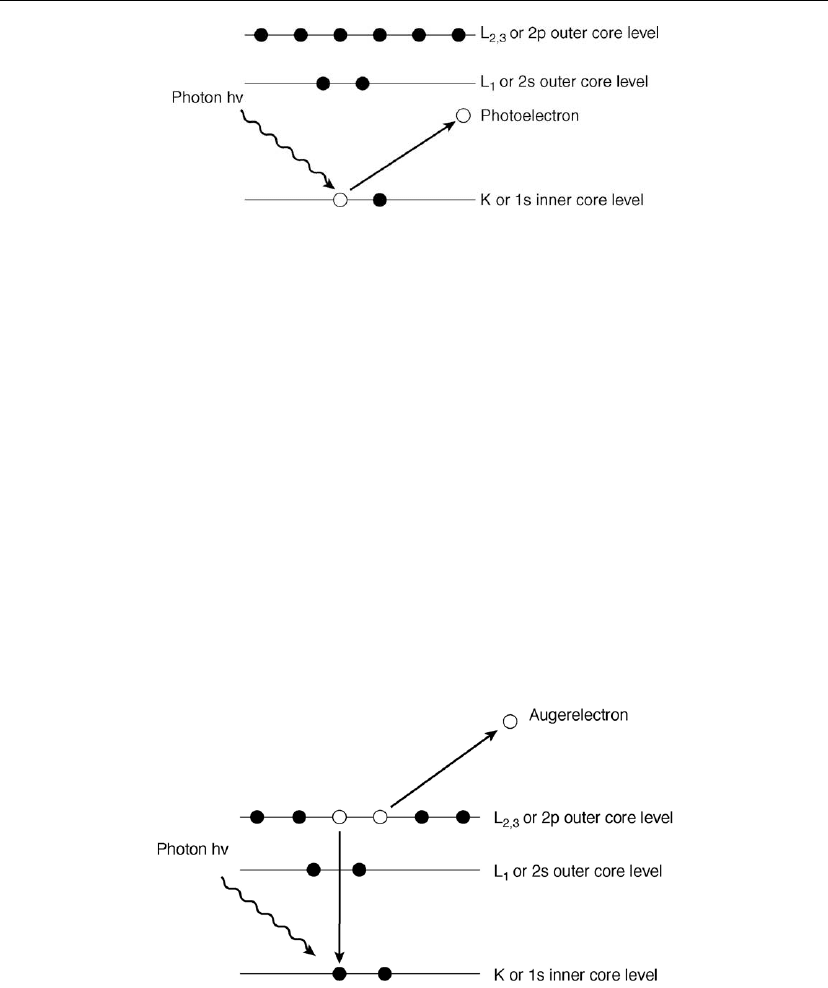
756 Chapter 16
Figure 16.3: Schematic diagram of photoemission process used for XPS. X-rays excite and remove
an electron from a core level. The kinetic energy of that electron is equal to the energy of the
photon, minus the binding energy of the core electron and the work function of the spectrometer
(kE =hv −BE −s) [10].
below the surface, making the practical limit ∼8–10 nm for determining non-destructive
composition as a function of depth analysis [13].
Electrons emitted from the sample without inelastic energy loss appear as spectral lines or
photoelectron peaks as a function of binding energy. Electrons that have lost energy appear as
spectral background. The energy of the photoelectrons emitted from the sample is
characteristic of each element and the binding energy (BE) of the ejected electrons is
determined from the measured kinetic energy (KE) by the following equation [7, 10, 14]:
BE = hv − KE −
s
(16.1)
Figure 16.4: Schematic diagram of the Auger process. A core-level vacancy (such as created in
Figure 16.3) is filled by an electron from a higher level shell and a third electron is emitted to
conserve energy. The energy of the emitted Auger electron, E
KLL
≈E
K
−E
L
−E
L
. Note that the
energy of the Auger electron is independent of the energy of the photon creating the core-level
vacancy [10].

Characterization of Thin Films and Coatings 757
where BE = binding energy of core level electron, hv = characteristic energy of X-ray photon,
KE = kinetic energy of ejected photoelectron, and
s
= spectrometer work function.
16.3.1.3 Data Collection
XPS data are collected in one of two different modes. Wide scans or survey spectra involve
the collection of data over a wide energy range, typically 1000 eV, and are important to
determine the true nature of the surface composition and can be used for quantification. An
example of a survey scan of an iron oxide grown on a silicon wafer is shown in Figure 16.5.
Note that in addition to the expected Fe and O photoelectron peaks the spectrum consists of
some other peaks. Some of them correspond to Auger peaks for Fe and O, while others
are due to contamination from C and F. Narrow scans collected at higher energy resolution and
smaller energy windows are useful for examining the chemical state of specific elements. The
Ce 3d photoelectron peaks from a ceria (CeO
2
) film which contains mostly Ce
4+
before and
after a reduction process, which introduces a significant amount of Ce
3+
, are shown in
Figure 16.6.
Figure 16.5: XPS survey scan of an iron oxide grown on a silicon wafer. In addition to Fe 2p and O
1s photoelectron peaks, O KLL and Fe LMM Auger peaks are observed. Also present are C and F
peaks from surface contamination.
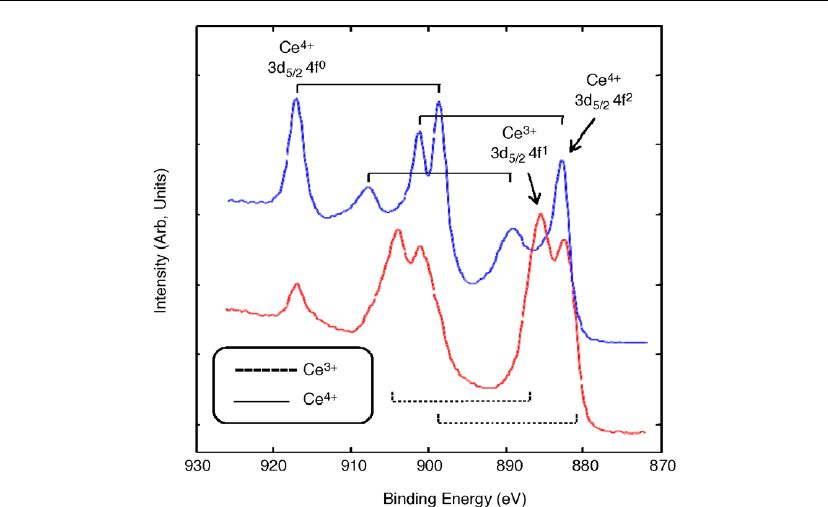
758 Chapter 16
Figure 16.6: Narrow scans of Ce 3d photoelectron peaks from a ceria (CeO
2
) film which contains
mostly Ce
4+
(top) and the film after a reduction process which introduces a significant amount
of Ce
3+
(bottom). High-resolution narrow scans for particular core levels provide useful
information about the chemical state information.
Starting in the 1990s, some XPS instruments have been developed with increased ability to
generate or collect photoelectrons from increasingly smaller regions of a specimen, taking
XPS into the realm of X-ray microscopy. Some modern laboratory-based instruments can
achieve spatial resolution approaching ∼1 m (higher resolution is possible using
synchrotron-based X-ray sources). An example of the spatial mapping available from an
instrument with ≈10 m spatial resolution is shown in Figure 16.7. This specific sample is a
magnification standard for which the dots are indium oxide-doped tin oxide (ITO) and the
surrounding coating consists of chromium oxide [15].
16.3.1.4 Depth Profiling
Depth profiling is now routinely possible with modern instruments equipped with ion guns and
high spatial resolution spectrometers (see Section 16.4.5). Depth profiling using ions for
etching (typically Ar and Xe) is routinely used to determine elemental or chemical profiles in a
film. The use of C
60
ions for sputtering of polymer films is becoming increasingly popular
since the damage induced by C
60
ions is less than that of inert gas ions.
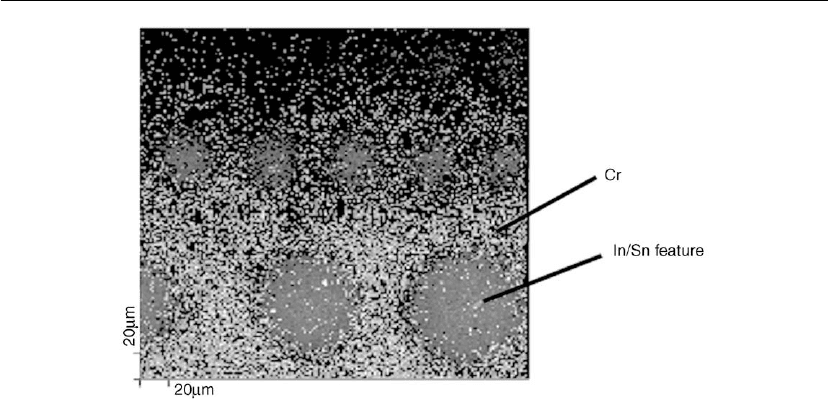
Characterization of Thin Films and Coatings 759
Figure 16.7: XPS surface elemental mapping of In/Sn circular features from a magnification
standard (MRS-3 magnification reference standard [15], Geller Microanalytical Laboratory) using
a Phi-Quantum Scanning XPS system (www.emsl.pnl.gov).
The use of any energetic ions for etching may be inappropriate for some sensitive materials
since chemical degradation may occur. For these types of sensitive samples the use of angle
resolved X-ray photoelectron spectroscopy (ARXPS) may be helpful in providing a
non-destructive depth profile of the near surface layer. ARXPS is accomplished by tilting the
sample to vary the angle between the axis of the photoelectron analyzer and the normal to the
sample surface (the photoemission angle, θ). XPS data can be collected at a series of
photoemission angles, θ, ranging from few degrees to 75
◦
. These angle resolved data can be
analyzed using a variety of available software tools that are commonly used to define the depth
distribution of chemical species and surface layering [16, 17]. IMFP values used in layer
thickness calculations can be obtained from the database of surface analysis by AES and XPS
[18, 19] by the National Institute of Standards and Technology (NIST).
16.3.1.5 Quantification
The number of photoelectrons detected from an element is dependent upon the concentrations
of that element in the sample. Electrons are detected, and data are digitized and analyzed by
computer software programs to measure the peak height or peak area after removal of the
spectral background [16, 20]. The use of a Shirley background subtraction [21] routine is one
of the more common methods for background subtraction. For quantification and chemical
state analysis, it is important to include or correct for X-ray satellites, chemically shifted

760 Chapter 16
spectral lines, shake-up peaks, and plasmon losses. Peak areas are used with empirically
derived sensitivity factors or atomic sensitivity factors (ASFs) in calculating the relative
concentrations [22, 23]. With the use of standards, an accuracy of 5% or better can be obtained
with a reproducibility of better than 2%. A simplified form of the basic expression for
quantitative XPS is given by the following equation [7, 10, 24]:
C
x
= (I
x
/S
x
)/(I
i
/S
i
) (16.2)
where C
x
= atomic concentration of element x, I
x
= measured intensity of photoelectron peak,
and S
x
= sensitivity factor for element x.
16.3.1.6 Strengths and Limitations of Incident Photon Methods
Strengths:
Measure surface elemental composition and chemical state information.
Generally, little or no damage except for some organics and polymers [18, 25].
Identification of all elements except for H and He.
Applicable for a wide variety of materials, including insulating samples.
Non-destructive depth information (up to 10 nm).
Depth profiling with matrix-level concentrations.
Thickness measurements.
Spatial resolution (x–y) for laboratory-based system currently limited to ∼1–10 m.
Limitations:
Require ultrahigh vacuum.
Detection limits typically ∼0.01–0.1 at.%.
Smallest analytical area ∼1–10 m.
Limited specific organic information.
Preferential sputtering can be a challenge during quantitative analysis.
16.3.2 X-Ray Diffraction and Reflection
P. Nachimuthu
XRD is one of the most powerful non-destructive bulk techniques for analyzing a wide range
of materials from research and development to production and engineering environments
